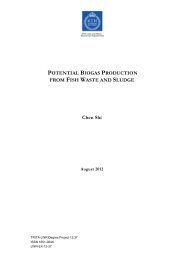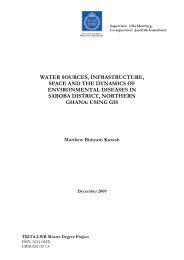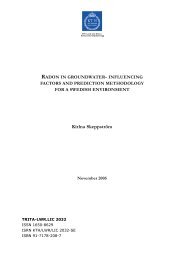Comparison between 1D and 2D models to analyze the dam break
Comparison between 1D and 2D models to analyze the dam break
Comparison between 1D and 2D models to analyze the dam break
- No tags were found...
You also want an ePaper? Increase the reach of your titles
YUMPU automatically turns print PDFs into web optimized ePapers that Google loves.
<strong>Comparison</strong> <strong>between</strong> <strong>1D</strong> <strong>and</strong> <strong>2D</strong> <strong>models</strong> <strong>to</strong> <strong>analyze</strong> <strong>the</strong> <strong>dam</strong> <strong>break</strong> waveTo conclude, <strong>the</strong> last assumption concerns about <strong>the</strong>bathymetry profiling. An unreal bathymetry has beengenerated for <strong>the</strong> <strong>1D</strong> model by <strong>the</strong> function sin(x)/10,which have been developed only downstream of <strong>the</strong><strong>dam</strong>, where it has <strong>the</strong> real influence.This function creates a group of small elevations of±10 cm downstream of <strong>the</strong> <strong>dam</strong>, in order <strong>to</strong> observe<strong>the</strong> big influence of <strong>the</strong> bathymetry profiling when <strong>the</strong><strong>dam</strong> <strong>break</strong> wave sweep along <strong>the</strong> valley. In <strong>the</strong>denomina<strong>to</strong>r of <strong>the</strong> function <strong>the</strong>re is a 10, it has beenonly <strong>the</strong> result after some different tests <strong>to</strong> prove <strong>the</strong>most suitable profile for <strong>the</strong> simulations.3.2 Dependent variables.Our dependent variables for this <strong>1D</strong> model are z <strong>and</strong>zv. Where z is <strong>the</strong> depth of water, <strong>and</strong> zv is <strong>the</strong> unitdischarge along <strong>the</strong> co-ordinate direction.3.3 Constants.In this model, we call ‘constants’ <strong>the</strong> variables that areindependent of <strong>the</strong> geometry. Constants are global,that is, <strong>the</strong>y are <strong>the</strong> same for all geometries <strong>and</strong>subdomains. In this <strong>1D</strong> model <strong>the</strong> following constantshave been used:Kinematic viscosity: ν = µ / ρIt is expressed as <strong>the</strong> dynamic viscosity divided by <strong>the</strong>density of <strong>the</strong> fluid. Kinematic viscosity is a measureof <strong>the</strong> resistive flow of a fluid under <strong>the</strong> influence ofgravity. Kinematic viscosity (Greek symbol nu: ν c ) hasSI units (m 2 s -1 ). The kinematic viscosity of water at20ºC is 10 -6 m 2 /s, <strong>and</strong> that is <strong>the</strong> value we assume forour model. This viscosity term is negligible; it has noinfluence although is has been taken in<strong>to</strong>consideration. In <strong>the</strong> <strong>2D</strong> model, <strong>the</strong> viscosity term isneglected <strong>and</strong> this is not an imprecise assumption.Acceleration due <strong>to</strong> gravityAt <strong>the</strong> Earth's surface, denoted g, is approximately 9.8m/s 2 (meters per second squared).Eddy diffusion coefficientIn fluid dynamics, an ‘eddy’ is <strong>the</strong> swirling of a fluid<strong>and</strong> <strong>the</strong> reverse current created when <strong>the</strong> fluid flowspast an obstacle. The moving fluid creates a spacedevoid of downstream-flowing water on <strong>the</strong>downstream side of <strong>the</strong> object. Fluid behind <strong>the</strong>obstacle flows in<strong>to</strong> <strong>the</strong> void creating a swirl of fluid oneach edge of <strong>the</strong> obstacle, followed by a short reverseflow of fluid behind <strong>the</strong> obstacle flowing upstream,<strong>to</strong>ward <strong>the</strong> back of <strong>the</strong> obstacle. This phenomenon ismost visible behind large emergent rocks in swiftflowingrivers.The ‘eddy diffusivity’ is <strong>the</strong> exchange coefficient for<strong>the</strong> diffusion of a conservative property by eddies in aturbulent flow. Also known as eddy-diffusioncoefficient. In this model, this coefficient is relevant <strong>to</strong>get <strong>the</strong> stability in <strong>the</strong> simulations. Without thiscoefficient, <strong>the</strong> results have been not satisfac<strong>to</strong>ry at all.We need this artificial diffusion for stabilizing <strong>the</strong>solution. The dispersion coefficient E has been set <strong>to</strong>2 m 2 /s.Manning's Roughness CoefficientRoughness coefficients represent <strong>the</strong> resistance <strong>to</strong>flood flows in channels <strong>and</strong> flood plains. Suggestedvalues for Manning's n, tabulated according <strong>to</strong> fac<strong>to</strong>rsthat affect roughness, are found in <strong>the</strong> literature.Roughness characteristics of natural channels are givenby Barnes (1967). Barnes presents pho<strong>to</strong>graphs <strong>and</strong>cross sections of typical rivers <strong>and</strong> creeks <strong>and</strong> <strong>the</strong>irrespective n values. From <strong>the</strong>se guides we fetch atypical value for flood plains, n = 0.025Figure 3. The Constants dialog box.3.4 Scalar expressions.The scalar expressions are used <strong>to</strong> define scalarexpression variables that are valid on all geometrylevels everywhere in <strong>the</strong> current geometry. Thefollowing expressions have been defined in <strong>the</strong> model:The bed profile z f has been defined in this way:z f = (0)*(x=52)This is <strong>the</strong> analytical expression that has been chosen<strong>to</strong> define <strong>the</strong> bathymetry in <strong>the</strong> <strong>1D</strong> model; it meansthat <strong>the</strong>re is a flat bed profile <strong>the</strong> first 52 m (upstreamof <strong>the</strong> <strong>dam</strong>) <strong>and</strong> a ‘sinusoidal’ bed profile downstreamof <strong>the</strong> <strong>dam</strong>, that is, <strong>the</strong> last 48 m of <strong>the</strong> one hundredmetres-domain.The derivative of z f with respect <strong>to</strong> <strong>the</strong> variable x hasbeen introduced here for computational effortreasons. Computing this term apart, <strong>the</strong> computerdoes not need <strong>to</strong> do it in <strong>the</strong> simulation for every finiteelement of <strong>the</strong> mesh, it takes simply <strong>the</strong> value which issaved here as ano<strong>the</strong>r expression. This term appears in<strong>the</strong> equations as we saw in [2.2].The initial value of <strong>the</strong> water layer z 0 has been set in<strong>the</strong> same way as <strong>the</strong> bed profile, that is: z 0 =(10)*(x=50). It is developed in detail in[3.7].The friction term seen in [2.3.1] has been introducedhere with a different expression but it is really <strong>the</strong>same. All <strong>the</strong> expressions as possible have been setapart from <strong>the</strong> equations for own convenience <strong>and</strong>computational effort reasons.7
















